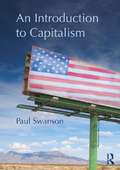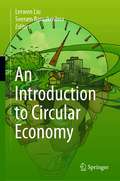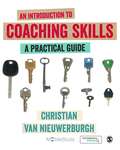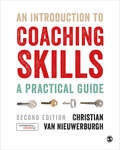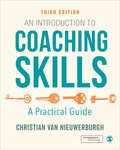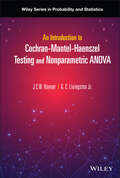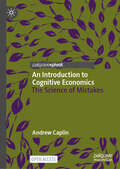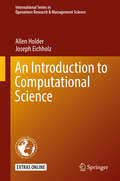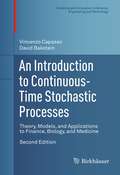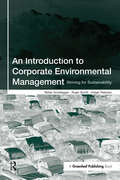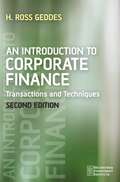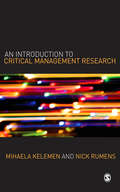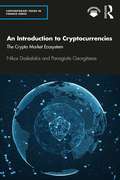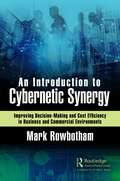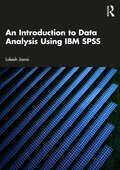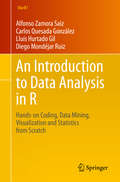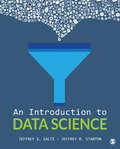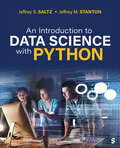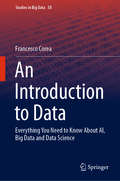- Table View
- List View
An Introduction to Capitalism
by Paul SwansonEmbedded in an historical account of the development of U.S. capitalism up to the present day, this book gives the reader a thorough description of the major aspects of the U.S. economy, as well as a theoretical understanding of the overall economy. A particular focus of this book is how free markets work in capitalism and the interrelationship between markets and the government. Of particular interest in the current economic situation is the question of what can the government do to get the economy going again. Underlying the standard economics text today is the fundamental belief that leaving markets as free as possible will lead to the ideal economy. Directly opposing this approach, this book takes a critical stance toward free markets. Rather than viewing markets as the ideal solution to almost all economic problems, this book argues that markets are not always the answer. On the contrary, they are often the problem, and must be corrected by government action. Related to this critical stance, and in a further departure from current economics texts, this book takes an explicitly Keynesian approach to the macro-economy. Rejecting the free market approach which dominates both micro- and macro-economics today, this book offers a fresh perspective on economics and the economy today.
An Introduction to Circular Economy
by Seeram Ramakrishna Lerwen LiuThis book is purposefully styled as an introductory textbook on circular economy (CE) for the benefit of educators and students of universities. It provides comprehensive knowledge exemplified by practices from policy, education, R&D, innovation, design, production, waste management, business and financing around the world. The book covers sectors such as agriculture/food, packaging materials, build environment, textile, energy, and mobility to inspire the growth of circular business transformation. It aims to stimulate action among different stakeholders to drive CE transformation. It elaborates critical driving forces of CE including digital technologies; restorative innovations; business opportunities & sustainable business model; financing instruments, regulation & assessment and experiential education programs. It connects a CE transformation for reaching the SDGs2030 and highlights youth leadership and entrepreneurship at all levels in driving the sustainability transformation.
An Introduction to Coaching Skills
by Christian Van NieuwerburghAn Introduction to Coaching Skills is an invaluable resource for novice and trainee coaches. Its accessible, step-by-step style acquaints you with the key skills needed to become a successful coach and, with its focus on the applied side of coaching, the book is an essential text for anyone starting out on their coaching voyage. From the 'how to', through to practicalities and challenges and honing existing skills, this book covers: - Definitions of coaching - How to become a coach - Key coaching skills - Current coaching models - Practical tools and techniques - Reflective practise and how best to help others With evidence-based research, activities and suggestions for further reading, this is a clear and practical, all-you-need guide to becoming a coach.
An Introduction to Coaching Skills: A Practical Guide
by Dr Christian Van NieuwerburghThis text is an invaluable resource for novice and trainee coaches. Its accessible, step-by-step style acquaints you with the key skills needed to become a successful coach. It takes you from the 'how to', through to practicalities and challenges, and beyond to the continued development of your skills. There is even more packed into the new edition, with: over 70 videos of real coaching; including two full length sessions for you to engage with a closer look at coaching processes and models to support your understanding new activities (including templates to download) to try with clients stories from practice to give context to the skills being discussed. A world-wide success, this is a stimulating, inspiring and hugely practical book that you’ll come back to time and time again.
An Introduction to Coaching Skills: A Practical Guide
by Dr Christian Van NieuwerburghThis text is an invaluable resource for novice and trainee coaches. Its accessible, step-by-step style acquaints you with the key skills needed to become a successful coach. It takes you from the 'how to', through to practicalities and challenges, and beyond to the continued development of your skills. There is even more packed into the new edition, with: over 70 videos of real coaching; including two full length sessions for you to engage with a closer look at coaching processes and models to support your understanding new activities (including templates to download) to try with clients stories from practice to give context to the skills being discussed. A world-wide success, this is a stimulating, inspiring and hugely practical book that you’ll come back to time and time again.
An Introduction to Coaching Skills: A Practical Guide
by Dr. Christian van NieuwerburghThis bestselling book introduces you step-by-step to the key skills needed to become a successful coach. Supported by an Online Resource site with over 70 videos of coaching in action, this practical book will be an invaluable resource for novices and trainee coaches. To access the exclusive SAGE Videos, please see the code on the inside front cover of your textbook and click on &“Login&” above. If you have purchased the eBook from Amazon or another online retailer, please email UK.DigitalContent DigitalContent@sagepub.co.uk> with the subject line &“Access Code Required&” and we will assist further.
An Introduction to Coaching Skills: A Practical Guide
by Dr. Christian van NieuwerburghThis bestselling book introduces you step-by-step to the key skills needed to become a successful coach. Supported by an Online Resource site with over 70 videos of coaching in action, this practical book will be an invaluable resource for novices and trainee coaches. To access the exclusive SAGE Videos, please see the code on the inside front cover of your textbook and click on &“Login&” above. If you have purchased the eBook from Amazon or another online retailer, please email UK.DigitalContent DigitalContent@sagepub.co.uk> with the subject line &“Access Code Required&” and we will assist further.
An Introduction to Cochran-Mantel-Haenszel Testing and Nonparametric ANOVA (Wiley Series in Probability and Statistics)
by J. C. Rayner G. C. Livingston Jr.An Introduction to Cochran-Mantel-Haenszel Testing and Nonparametric ANOVA Complete reference for applied statisticians and data analysts that uniquely covers the new statistical methodologies that enable deeper data analysis An Introduction to Cochran-Mantel-Haenszel Testing and Nonparametric ANOVA provides readers with powerful new statistical methodologies that enable deeper data analysis. The book offers applied statisticians an introduction to the latest topics in nonparametrics. The worked examples with supporting R code provide analysts the tools they need to apply these methods to their own problems. Co-authored by an internationally recognised expert in the field and an early career researcher with broad skills including data analysis and R programming, the book discusses key topics such as: NP ANOVA methodology Cochran-Mantel-Haenszel (CMH) methodology and design Latin squares and balanced incomplete block designs Parametric ANOVA F tests for continuous data Nonparametric rank tests (the Kruskal-Wallis and Friedman tests) CMH MS tests for the nonparametric analysis of categorical response data Applied statisticians and data analysts, as well as students and professors in data analysis, can use this book to gain a complete understanding of the modern statistical methodologies that are allowing for deeper data analysis.
An Introduction to Cognitive Economics: The Science of Mistakes
by Andrew CaplinThis book introduces readers to “cognitive economics,” a rapidly emerging interdisciplinary science built on economic, psychological, and data scientific foundations. Throughout the book, economist Andrew Caplin provides new approaches to help scholars collaborate and solve problems that can shape economic outcomes and bridge the gap between theoretical knowledge and the real world. Divided into two parts, the first section brings readers up to speed on economic concepts that underlie decision-making mistakes, such as utility functions, subjective beliefs, and costs of learning. It also explores real-world applications, including improvements in legal decision-making, online privacy protection, and optimizing human-AI collaboration. The book also discusses the future impact of AI on the workforce and emphasizes the need for decision-making skills and financial literacy in navigating this evolving landscape. In the second section of the book, Caplin addresses the barriers to progress within social sciences, advocating for interdisciplinary cooperation and innovative measurement techniques to advance the field. The book invites readers to contribute to the development of cognitive economics. Whether you are a socially-conscious and hard-working citizen, business leader, scholar, or policymaker, this book will help you understand why cognitive economics matters to you and how you can contribute to its takeoff. This book is available open access, which means it is freely available online.
An Introduction to Computational Science (International Series in Operations Research & Management Science #278)
by Allen Holder Joseph EichholzThis textbook provides an introduction to the growing interdisciplinary field of computational science. It combines a foundational development of numerical methods with a variety of illustrative applications spread across numerous areas of science and engineering. The intended audience is the undergraduate who has completed introductory coursework in mathematics and computer science. Students gain computational acuity by authoring their own numerical routines and by practicing with numerical methods as they solve computational models. This education encourages students to learn the importance of answering: How expensive is a calculation, how trustworthy is a calculation, and how might we model a problem to apply a desired numerical method?The text is written in two parts. Part I provides a succinct, one-term inauguration into the primary routines on which a further study of computational science rests. The material is organized so that the transition to computational science from coursework in calculus, differential equations, and linear algebra is natural. Beyond the mathematical and computational content of Part I, students gain proficiency with elemental programming constructs and visualization, which are presented in MATLAB syntax. The focus of Part II is modeling, wherein students build computational models, compute solutions, and report their findings. The models purposely intersect numerous areas of science and engineering to demonstrate the pervasive role played by computational science.
An Introduction to Continuous-Time Stochastic Processes: Theory, Models, and Applications to Finance, Biology, and Medicine (Modeling and Simulation in Science, Engineering and Technology)
by Vincenzo Capasso David BaksteinThis textbook, now in its third edition, offers a rigorous and self-contained introduction to the theory of continuous-time stochastic processes, stochastic integrals, and stochastic differential equations. Expertly balancing theory and applications, the work features concrete examples of modeling real-world problems from biology, medicine, industrial applications, finance, and insurance using stochastic methods. No previous knowledge of stochastic processes is required. Key topics include:Markov processesStochastic differential equationsArbitrage-free markets and financial derivativesInsurance riskPopulation dynamics, and epidemicsAgent-based modelsNew to the Third Edition:Infinitely divisible distributionsRandom measuresLevy processesFractional Brownian motionErgodic theoryKarhunen-Loeve expansionAdditional applicationsAdditional exercisesSmoluchowski approximation of Langevin systemsAn Introduction to Continuous-Time Stochastic Processes, Third Edition will be of interest to a broad audience of students, pure and applied mathematicians, and researchers and practitioners in mathematical finance, biomathematics, biotechnology, and engineering. Suitable as a textbook for graduate or undergraduate courses, as well as European Masters courses (according to the two-year-long second cycle of the "Bologna Scheme"), the work may also be used for self-study or as a reference. Prerequisites include knowledge of calculus and some analysis; exposure to probability would be helpful but not required since the necessary fundamentals of measure and integration are provided. From reviews of previous editions:"The book is . . . an account of fundamental concepts as they appear in relevant modern applications and literature. . . . The book addresses three main groups: first, mathematicians working in a different field; second, other scientists and professionals from a business or academic background; third, graduate or advanced undergraduate students of a quantitative subject related to stochastic theory and/or applications. " -Zentralblatt MATH
An Introduction to Corporate Environmental Management: Striving for Sustainability
by Stefan Schaltegger Roger Burritt Holger PetersenThis book is designed to meet the urgent need for a comprehensive and definitive introduction and teaching text on corporate environmental management. It aims to become the standard textbook for courses examining how business can take the environment into account while also providing an accessible and thorough overview of this increasingly multidisciplinary subject for practitioners.Written by the internationally acknowledged experts Stefan Schaltegger and Roger Burritt (authors of the highly influential Contemporary Environmental Accounting) along with Holger Petersen, the book invites the reader to join in an exploration of the ways in which companies can engage in environmental management and why such engagement can be profitable for business. The reader is invited to: examine whether the contents reflect their own experience, takes their experience further, or opposes their own views; note which of the ideas presented are especially important, add to those ideas, or encourage a reaction (positive or negative); answer questions creatively (based on their own perspective of the issues); encourage themselves to be inspired by questions, which can be investigated further through other written sources of information, such as books you will be guided to through the bibliography, the Internet or the general media; and think about and plan the ways in which the knowledge provided can be implemented in your own situation.The book is organised into four main sections. First, the fundamental ideas and linkages behind business management, the environment and sustainable development are briefly but clearly sketched. The second part of the book outlines the criteria against which environmentally oriented business management can be assessed and the fields of action in which success can be achieved. The third part presents a discussion and examples of strategies for environmental management, which are linked, in the fourth part, to the essential tools of environmental management, especially green marketing, environmental accounting and eco-control.The book is full of case studies and examples related to the main contents of each chapter and each chapter provides a number of questions for the student or reader to address.An Introduction to Corporate Environmental Management is both a textbook and a sourcebook. The reader can either work through the material in a structured way or dip into the content and follow up on specific areas of interest. The materials are designed to be used for understanding and reference, rather than to be learned by heart. The primary aim is for the reader to obtain a practical understanding of the relationship between management and environmental issues which can be applied in day-to-day situations-whether as part of a student's wider view of management or within the practitioner's real-world situation. It will be essential reading for many years to come.
An Introduction to Corporate Finance
by Ross GeddesAn Introduction to Corporate Finance provides the reader with a complete overview of Corporate Finance from perspective of the investment Banker. The author, a corporate trainer and former investment banker clarifies the role of the investment banker in numerous corporate finance transactions, including mergers & acquisitions, IPO's, and valuation. Given today's corporate climate, every student studying corporate finance and those working in the field need this book to sharpen their skill set.
An Introduction to Critical Management Research
by Mihaela L. Kelemen Nick Rumens`This book offers a lively and readable account of how scholars and students might engage with some of the more unusual critical theories associated with the critical management research project. Supported by a wealth of empirical and theoretical material, this book will introduce readers to the complex issues surrounding how to carry out critical management research rather than simply providing prescriptive answers' - Heather Höpfl, University of Essex `Kelemen and Rumens have done management scholars a great service in reviewing a huge amount of disparate knowledge and compressing it into a succinct, lively and provocative book on the current state of Critical Management Studies. This is a "must-read" for those both inside and outside CMS' - Keith Grint, Cranfield University `Management is a critical term for contemporary politics, but getting to grips with managerialism requires research methods that can deal with contemporary and controversial topics. This book provides the tools for that project, and will be invaluable for scholars and students who wish to challenge the conservatism of management academy at the present time' - Martin Parker, University of Leicester Why have certain theories shaped management research? Where do research theory and practice meet, if at all? To ask these questions is to think critically about management research. Mihaela L Kelemen and Nick Rumens explore the fundamentals of critical management theory and their influences on management research, and in doing so offer the student an illuminating introduction to what is often a disparate and complex array of issues. 10 expressive chapters examine theoretical foundations, including those most often sidelined in mainstream management theory; from postmodernism and deconstruction to American pragmatism, along with methodological choices and the intellectual issues each of these presents. Also provided is a timely consideration to the consequences and ethical concerns now inherent to any research issue.
An Introduction to Cryptocurrencies: The Crypto Market Ecosystem (Contemporary Issues in Finance)
by Nikos Daskalakis Panagiotis GeorgitseasThe Crypto Market Ecosystem has emerged as the most profound application of blockchain technology in finance. This textbook adopts an integrated approach, linking traditional functions of the current financial system (payments, traded assets, fundraising, regulation) with the respective functions in the crypto market, in order to facilitate the reader in their understanding of how this new ecosystem works. The book walks the reader through the main features of the blockchain technology, the definitions, classifications, and distinct characteristics of cryptocurrencies and tokens, how these are evaluated, how funds are raised in the cryptocurrency ecosystem (ICOs), and what the main regulatory approaches are. The authors have compiled more than 100 sources from different sub-fields of economics, finance, and regulation to create a coherent textbook that provides the reader with a clear and easily understandable picture of the new world of encrypted finance and its applications. The book is primarily aimed at business and finance students, who already have an understanding of the basic principles of how the financial system works, but also targets a more general readership, by virtue of its broader scope and engaging and accessible tone.
An Introduction to Cybernetic Synergy: Improving Decision-Making and Cost Efficiency in Business and Commercial Environments
by Mark RowbothamCybernetics is about having a goal and taking action to achieve that goal. Knowing whether you have reached your goal (or at least are getting closer to it) requires “feedback”, a concept that was made rigorous by cybernetics. The subject of Cybernetic Synergy, although emanating from a socio-economic experiment of economic control by cybernetic means in Chile in the early 1970s, has never been approached as an applied subject in its own right. Indeed, the subject of applied cybernetics has never been addressed as a separate issue, although it has been shown that the overall subject of cybernetics applies to a wide range of disciplines, from biology to business via mathematics and engineering. Cybernetic synergy is the study of relationships and controls of and between corporate entities, on an external basis, and departments within corporate entities, on an internal basis. It concerns the decision-making process, and how decisions can be made based on feedback from any part of the organization being managed. It therefore concerns the issue of input of raw material or information, the output of the transformed information and materials, and the rectification of any issue based on negative feedback related to the productive process. It investigates not only the basic theory of the subject but also its applications in the commercial and business environment, as well as touching on government and administrative issues where shortcomings have emerged owing to a lack of synergy and communication. There are already several books available on the subject to cybernetics, but they are all concerned with mathematical approaches along with very heavy technical texts, most of which are completely alien to the layman or the simple practitioner. Furthermore, other than references to business or economic practice in some books, there has never been a book published purely about the subject of applied cybernetics relating to business practices. The book covers the subjects of management and economic cybernetics, and how the theory of cybernetic control can be used to manage business and government functions, whether small, medium or large. It looks at the history of cybernetics, and how some pioneering cybernetic concepts were used in Chile in the early 1970s to manage the Chilean economy. It uses these same principles, along with later cybernetic models, to show how such concepts can be applied to the present-day economy and business practices. It examines present-day business practices and shows how weaknesses in these systems can be addressed and eliminated by the application of cybernetic practices. The aims of the book are to provide an insight into the subject of management and business cybernetics, using the principle of cybernetic synergy, to resolve intra-corporate issues and create more efficient business practices based on simple command-and-control processes. Essentially, this book provides an in-depth insight into the use of cybernetics in business and administration environments, and would explain how cybernetics is a valuable tool in resolving corporate issues concerning efficiency and overall control. It would give a detailed explanation of the various practices and functions involved in business operations and practices.
An Introduction to Data Analysis Using IBM SPSS
by Lokesh JasraiThis textbook elaborates on the basic understanding and application of statistical tests and data analysis using hypothetical datasets and SPSS version 22.0. It presents step-by-step processes and to-the-point interpretation for quick assimilation and comprehension.Data Analysis Using SPSS Begins with the stages of data entry and goes on till editing and data visualization. Takes the readers through descriptive statistics, frequency, univariate, bivariate and regression analysis, cross-tabulation, linear models and non-parametric test procedures. Presents information through dialog boxes and tabular charts, and also incorporates important formulae, calculations and illustrations of sample data for an in-depth understanding of concepts and results. Can be used as a textbook as well as a reference book as it helps to build conceptual understanding, gaining software skills, and communicates data and its insights to accomplish research assignments, research/capstone projects and PhD research work. With comprehensive coverage, this book would be useful to the students, researchers and teachers of the various social sciences disciplines like Psychology, Sociology, Education, Social Work, Agriculture Management and other allied subjects. It would also be an invaluable companion to professionals and data scientists working in the field of analytics.
An Introduction to Data Analysis in R: Hands-on Coding, Data Mining, Visualization and Statistics from Scratch (Use R!)
by Alfonso Zamora Saiz Carlos Quesada González Lluís Hurtado Gil Diego Mondéjar RuizThis textbook offers an easy-to-follow, practical guide to modern data analysis using the programming language R. The chapters cover topics such as the fundamentals of programming in R, data collection and preprocessing, including web scraping, data visualization, and statistical methods, including multivariate analysis, and feature exercises at the end of each section. The text requires only basic statistics skills, as it strikes a balance between statistical and mathematical understanding and implementation in R, with a special emphasis on reproducible examples and real-world applications. This textbook is primarily intended for undergraduate students of mathematics, statistics, physics, economics, finance and business who are pursuing a career in data analytics. It will be equally valuable for master students of data science and industry professionals who want to conduct data analyses.
An Introduction to Data Science
by Jeffrey S. Saltz Jeffrey Morgan StantonAn Introduction to Data Science is an easy-to-read, gentle introduction for advanced undergraduate, certificate, and graduate students coming from a wide range of backgrounds into the world of data science. After introducing the basic concepts of data science, the book builds on these foundations to explain data science techniques using the R programming language and RStudio® from the ground up. Short chapters allow instructors to group concepts together for a semester course and provide students with manageable amounts of information for each concept. By taking students systematically through the R programming environment, the book takes the fear out of data science and familiarizes students with the environment so they can be successful when performing advanced functions. The authors cover statistics from a conceptual standpoint, focusing on how to use and interpret statistics, rather than the math behind the statistics. This text then demonstrates how to use data effectively and efficiently to construct models, predict outcomes, visualize data, and make decisions. Accompanying digital resources provide code and datasets for instructors and learners to perform a wide range of data science tasks.
An Introduction to Data Science
by Jeffrey S. Saltz Jeffrey Morgan StantonAn Introduction to Data Science is an easy-to-read, gentle introduction for advanced undergraduate, certificate, and graduate students coming from a wide range of backgrounds into the world of data science. After introducing the basic concepts of data science, the book builds on these foundations to explain data science techniques using the R programming language and RStudio® from the ground up. Short chapters allow instructors to group concepts together for a semester course and provide students with manageable amounts of information for each concept. By taking students systematically through the R programming environment, the book takes the fear out of data science and familiarizes students with the environment so they can be successful when performing advanced functions. The authors cover statistics from a conceptual standpoint, focusing on how to use and interpret statistics, rather than the math behind the statistics. This text then demonstrates how to use data effectively and efficiently to construct models, predict outcomes, visualize data, and make decisions. Accompanying digital resources provide code and datasets for instructors and learners to perform a wide range of data science tasks.
An Introduction to Data Science With Python
by Jeffrey S. Saltz Jeffrey Morgan StantonAn Introduction to Data Science with Python by Jeffrey S. Saltz and Jeffery M. Stanton provides readers who are new to Python and data science with a step-by-step walkthrough of the tools and techniques used to analyze data and generate predictive models. After introducing the basic concepts of data science, the book builds on these foundations to explain data science techniques using Python-based Jupyter Notebooks. The techniques include making tables and data frames, computing statistics, managing data, creating data visualizations, and building machine learning models. Each chapter breaks down the process into simple steps and components so students with no more than a high school algebra background will still find the concepts and code intelligible. Explanations are reinforced with linked practice questions throughout to check reader understanding. The book also covers advanced topics such as neural networks and deep learning, the basis of many recent and startling advances in machine learning and artificial intelligence. With their trademark humor and clear explanations, Saltz and Stanton provide a gentle introduction to this powerful data science tool. Included with this title: LMS Cartridge: Import this title’s instructor resources into your school’s learning management system (LMS) and save time. Don′t use an LMS? You can still access all of the same online resources for this title via the password-protected Instructor Resource Site.
An Introduction to Data Science With Python
by Jeffrey S. Saltz Jeffrey Morgan StantonAn Introduction to Data Science with Python by Jeffrey S. Saltz and Jeffery M. Stanton provides readers who are new to Python and data science with a step-by-step walkthrough of the tools and techniques used to analyze data and generate predictive models. After introducing the basic concepts of data science, the book builds on these foundations to explain data science techniques using Python-based Jupyter Notebooks. The techniques include making tables and data frames, computing statistics, managing data, creating data visualizations, and building machine learning models. Each chapter breaks down the process into simple steps and components so students with no more than a high school algebra background will still find the concepts and code intelligible. Explanations are reinforced with linked practice questions throughout to check reader understanding. The book also covers advanced topics such as neural networks and deep learning, the basis of many recent and startling advances in machine learning and artificial intelligence. With their trademark humor and clear explanations, Saltz and Stanton provide a gentle introduction to this powerful data science tool. Included with this title: LMS Cartridge: Import this title’s instructor resources into your school’s learning management system (LMS) and save time. Don′t use an LMS? You can still access all of the same online resources for this title via the password-protected Instructor Resource Site.
An Introduction to Data: Everything You Need to Know About AI, Big Data and Data Science (Studies in Big Data #50)
by Francesco CoreaThis book reflects the author’s years of hands-on experience as an academic and practitioner. It is primarily intended for executives, managers and practitioners who want to redefine the way they think about artificial intelligence (AI) and other exponential technologies. Accordingly the book, which is structured as a collection of largely self-contained articles, includes both general strategic reflections and detailed sector-specific information. More concretely, it shares insights into what it means to work with AI and how to do it more efficiently; what it means to hire a data scientist and what new roles there are in the field; how to use AI in specific industries such as finance or insurance; how AI interacts with other technologies such as blockchain; and, in closing, a review of the use of AI in venture capital, as well as a snapshot of acceleration programs for AI companies.
An Introduction to Decision Theory
by Martin PetersonThis introduction to decision theory offers comprehensive and accessible discussions of decision-making under ignorance and risk, the foundations of utility theory, the debate over subjective and objective probability, Bayesianism, causal decision theory, game theory, and social choice theory. No mathematical skills are assumed, and all concepts and results are explained in non-technical and intuitive as well as more formal ways. There are over 100 exercises with solutions, and a glossary of key terms and concepts. An emphasis on foundational aspects of normative decision theory (rather than descriptive decision theory) makes the book particularly useful for philosophy students, but it will appeal to readers in a range of disciplines including economics, psychology, political science and computer science.
An Introduction to Decision Theory
by Martin PetersonThis introduction to decision theory offers comprehensive and accessible discussions of decision-making under ignorance and risk, the foundations of utility theory, the debate over subjective and objective probability, Bayesianism, causal decision theory, game theory, and social choice theory. No mathematical skills are assumed, and all concepts and results are explained in non-technical and intuitive as well as more formal ways. There are over 100 exercises with solutions, and a glossary of key terms and concepts. An emphasis on foundational aspects of normative decision theory (rather than descriptive decision theory) makes the book particularly useful for philosophy students, but it will appeal to readers in a range of disciplines including economics, psychology, political science and computer science.
